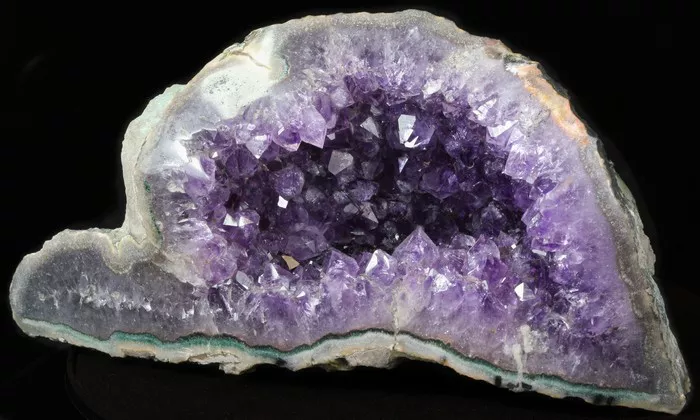Gemstones have fascinated humanity for millennia, captivating us with their mesmerizing colors, intricate formations, and alleged metaphysical properties. Among these gems, amethyst holds a special place, renowned for its striking purple hues and purported spiritual attributes. However, a recent trend has emerged in the world of gemstone jewelry: aura-treated amethyst. This treatment alters the gem’s appearance, sparking debates among enthusiasts about its authenticity and implications. In this article, we delve deep into the realm of aura-treated amethyst, exploring its origins, methods, and the implications for both consumers and the gemstone industry.
Before delving into aura-treated amethyst, it’s crucial to grasp the concept of gemstone treatments. Gemstones often undergo various treatments to enhance their appearance or improve their marketability. These treatments can range from simple heat treatments to more complex processes involving chemicals or coatings. While some treatments are widely accepted within the industry, others raise ethical and authenticity concerns.
The Aura Treatment
Aura treatment, also known as aura coating or vapor deposition, is a relatively modern technique used to enhance the appearance of gemstones. This process involves applying a thin metallic coating to the surface of the gemstone, imbuing it with iridescent colors and a distinct shimmering effect. While aura treatment is commonly associated with quartz crystals, including amethyst, it has sparked controversy due to its impact on the gem’s natural properties and transparency.
The Evolution of Aura-Treated Amethyst
Historically, amethyst has been prized for its natural beauty and purported healing properties. However, as demand for unique and visually stunning gemstones grew, jewelers and gemologists began exploring innovative ways to enhance amethyst’s allure. This led to the development of aura-treated amethyst, which quickly gained popularity in the jewelry market.
Aura treatment typically involves placing amethyst crystals in a vacuum chamber and introducing vaporized metallic elements, such as gold, titanium, or platinum. These metallic particles adhere to the surface of the crystals, creating a thin coating that alters their appearance. The result is a kaleidoscopic array of colors, ranging from vibrant purples to iridescent blues and greens.
Controversies Surrounding Aura-Treated Amethyst
While aura-treated amethyst may dazzle with its enchanting colors, it has sparked considerable debate within the gemstone community. Critics argue that the treatment diminishes the gem’s natural beauty and authenticity, blurring the line between natural and enhanced gemstones. Additionally, concerns have been raised about the long-term stability of aura-treated amethyst, as the metallic coating may degrade over time, affecting the gem’s appearance and durability.
Ethical considerations also come into play, as consumers may unknowingly purchase aura-treated amethyst under the assumption that it is entirely natural. This raises questions about transparency within the gemstone industry and the responsibility of jewelers and retailers to disclose treatments accurately.
Navigating the Market:
For consumers seeking genuine amethyst gemstones, distinguishing between natural and aura-treated specimens can be challenging. While some aura-treated amethyst may exhibit obvious signs of enhancement, such as intense iridescence or unnatural color combinations, others may appear deceptively similar to their natural counterparts.
One method of identifying aura-treated amethyst is through careful examination under magnification. Aura-treated specimens may display microscopic irregularities or inconsistencies in the metallic coating, indicating human intervention. Additionally, reputable jewelers and gemologists can provide certification or documentation verifying the authenticity of natural gemstones, offering peace of mind to consumers.
The Future of Aura-Treated Gemstones
As the demand for unique and visually striking gemstones continues to grow, aura-treated gemstones are likely to remain a prominent feature of the jewelry market. However, the ethical and authenticity concerns surrounding these treatments underscore the importance of transparency and consumer education.
Moving forward, stakeholders within the gemstone industry must prioritize ethical sourcing practices and accurate disclosure of gemstone treatments. By fostering transparency and consumer trust, the industry can ensure that enthusiasts can enjoy the beauty of gemstones like amethyst with confidence and peace of mind.
Conclusion
Aura-treated amethyst represents a captivating fusion of natural beauty and human ingenuity, offering a glimpse into the evolving landscape of gemstone treatments. While these enhancements may enhance the gem’s visual appeal, they also raise important questions about authenticity, transparency, and ethical sourcing within the gemstone industry.
As consumers, it’s essential to educate ourselves about gemstone treatments and seek out reputable sources when purchasing gemstone jewelry. By making informed choices and supporting ethical practices, we can contribute to a more transparent and sustainable gemstone industry, ensuring that the allure of gemstones like amethyst continues to enchant generations to come.


